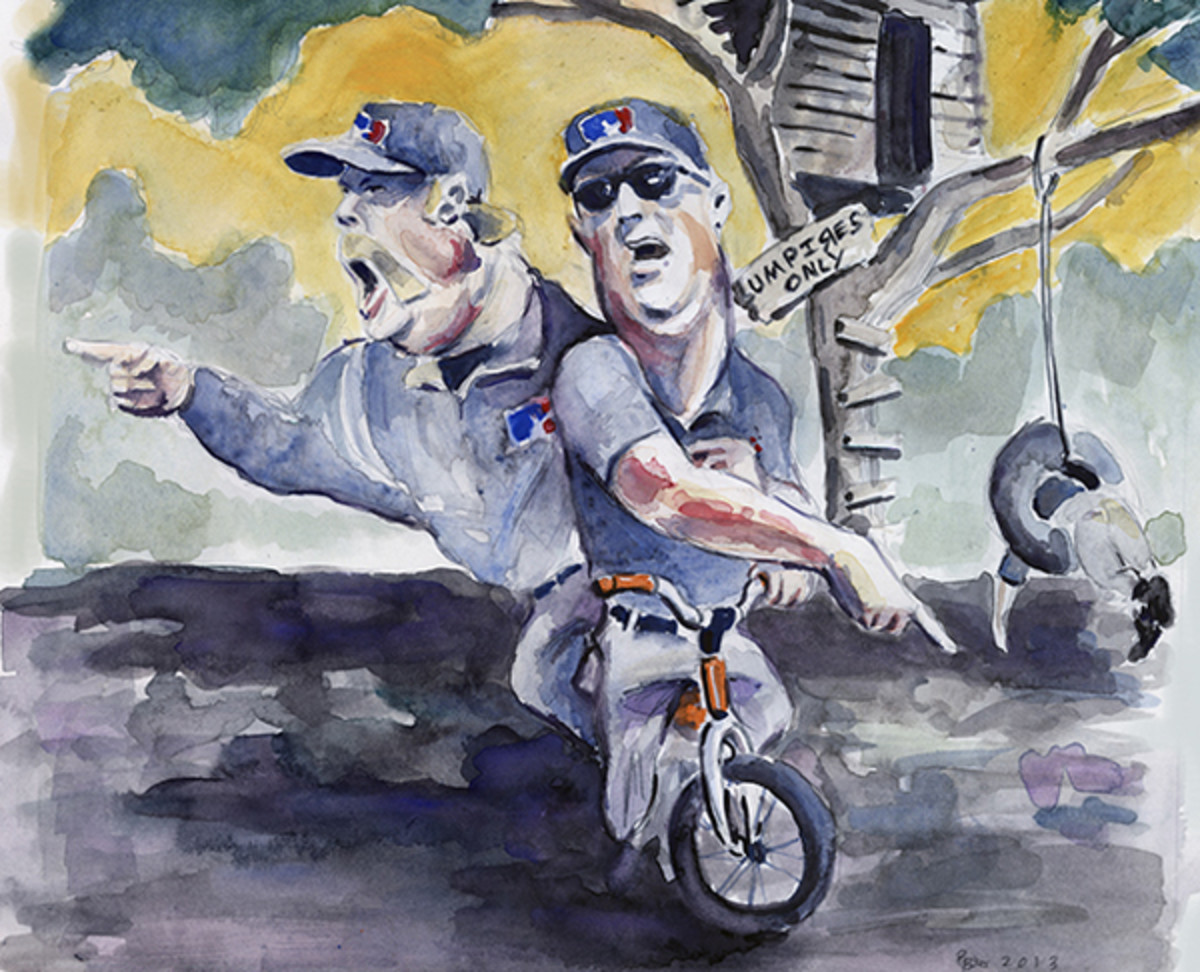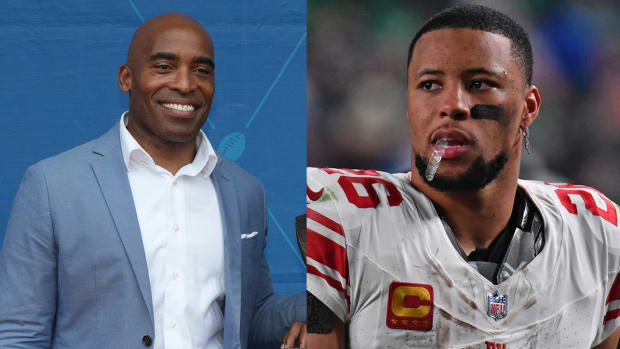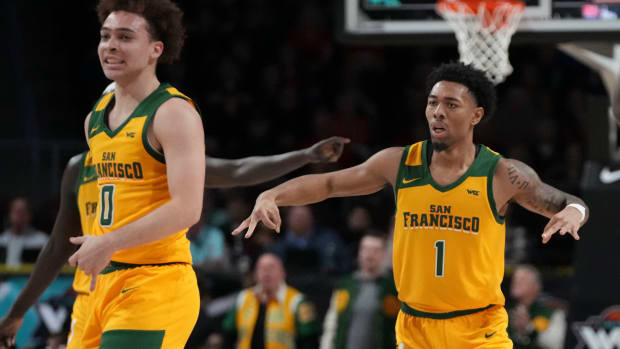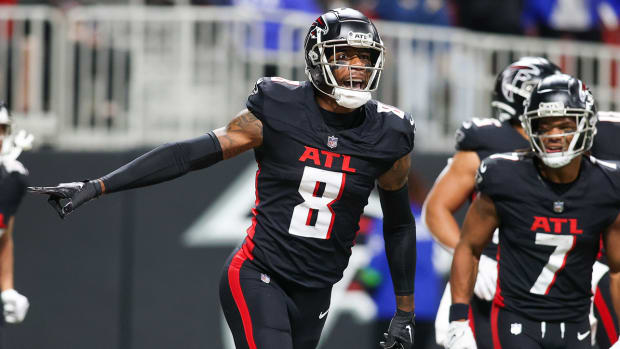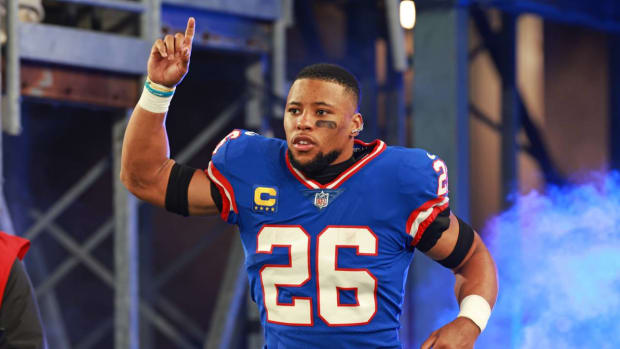Drafting Umps and Counting Ejections: The Fantasy League That Keeps MLB Honest
Art by Robert Bates || rb-portraits.com
In 1968, a dozen years before journalist Daniel Okrent invented fantasy (née rotisserie) baseball, Robert Coover published one of the all-time great fantasy sports novels: “The Universal Baseball Association, Inc., J. Henry Waugh, Prop.” In it, the title character plays out the events of an imagined baseball league each night at his dining table, with a scorecard in one hand and a trio of action-determining dice in the other. The Universal Baseball League and its inventiveness—roll enough consecutive triple ones and the pitcher will clock the hitter with a fatal bean ball—is a romanticized look at fantasy sports that bears almost no resemblance to the modern games played now on Yahoo! and ESPN.com. Most of today’s sports fantasists don’t invent much of anything, save for bad puns in their team names.
Yet there are still pockets of innovation in the increasingly mainstream fantasy ecosystem. The members of the Umpire Ejection Fantasy League don’t pore over the counting stats of baseball players, and it's not home runs or quality starts that score points. Instead, UEFL teams are comprised of MLB’s 68 umpires. They earn points when those umps eject argumentative coaches and incensed hitters. It's about as inside-baseball as a fantasy league can get, though it's not driven by a pretentious desire to be different. The aim, according to founder and co-commissioner Gil Imber, is justice. The fantasy being offered by the UEFL is one where the calls are always right; where someone umps the umpires. Join the UEFL and you won't just be playing GM—you'll be a justice in the Supreme Court of baseball.
The league was started in 2006 by Imber, who studied criminology at UC Irvine. Now 25, he works in the baseball industry (he didn't want to say any more about his gig than that), blogs for a securities law firm, and officiates local college sports. A guy who likes rules, he sums up his sports philosophy as “I’m on the ball’s side,” and it's that belief system that underpins the UEFL. As soon as an MLB player or coach gets sent to the showers, UEFL's members run to the tape to determine if the ejection was the right call. If the dismissal stemmed from an accurate call, the GM with that umpire on his team is rewarded. If it was a blown call that precipitated the ejection, points are docked. No ejection error goes unnoticed.
“I’m of the belief that umps are going to miss calls,” Imber said via email. “That’s part of the human element of the game. But at the same time, there’s something to be said for going back and saying that they got it wrong based on objective analysis.”
Focus notwithstanding, the UEFL is structured much like any other fantasy league. Each GM—there were 161 teams this year—drafts five umps at the beginning of the season: A crew chief, two primary umpires and two secondary umpires. As there are only 68 full-time umps, multiple teams can draft the same official—meaning that ejection-prone types like Marty Foster have a spot on many of those 161 squads. (Anyone is welcome to join.) Once lineups are set, that's it. There are no trades. If an ump goes on the DL, the affected GM gets his replacement.
Ed Zurga/Getty Images
Though ejections are some of the best theater in baseball, they're also relatively rare: As of September 27, there have been 179 ejections this season. The two most ejection-prone umps, Clint Fagan and Chad Fairchild, have both tossed players on only eight occasions, though six of Fagan's came on a June 11 brawl between the Dodgers and Diamondbacks. Other umps, like Tim Welke and Fieldin Culbreth, have made it to the season's final week without tossing anyone.
As a result, points are scarce in the UEFL. The current first place team has a whopping 66 points (though extra points are awarded to umps who earn a spot officiating the playoffs). A winning team is one that marries prestige and accuracy with that certain righteous hot-headedness.
"You need the right balance of ejections and accuracy," said co-commissioner Jeremy Dircks. "An ump who has 100% accuracy is not going to earn many points if he only has a couple of ejections." According to the league's vast repository of ejection stats, the debated call is correct in about 70% of all dismissals.
With all the information the UEFL's lay-historians have amassed, Imber can rattle off all sorts of ejection-related trivia. For example: "Most ejections occur when a team is already losing a game (101 ejections while losing vs. 40 when winning, with 38 when tied in 2012)." And: "An ejection during a tied game adversely affects the ejected person's team. Out of the 38 tied games in 2012, the ejectee's team went on to lose 25 times—a .342 winning percentage. In 2011, the win-loss record for an ejected player's team in tied games was 20-31 (.392)."
But more compelling is the fact that Imber & Co. are compiling a data set that not even MLB tracks. The league doesn't consider an ejection an official stat, and Michael Teevan, a spokesman for MLB, said via email that ejections are “not something we’d choose to highlight for individual umpires.” Umpire scrutiny isn't new—who doesn't love to ask the ump if he needs glasses?—but over the past decade a rapacious sports media, HD viewing at home, and sophisticated tracking tools like PITCHf/x have made it far easier to second guess what happens on the field. The spotlight on umps is brighter than ever—and finally, the league is going to do something to lessen the glare.
